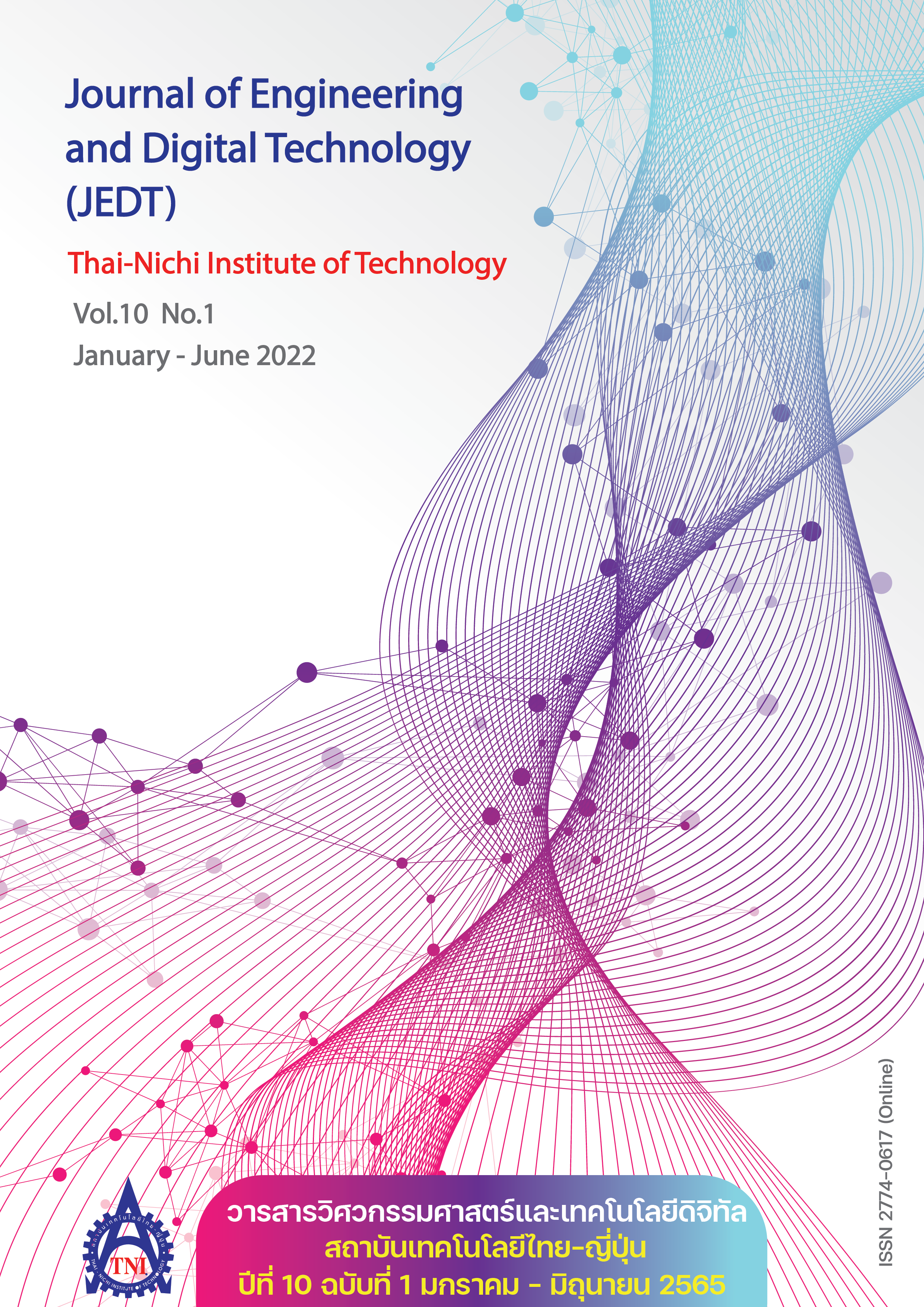A PM2.5 Prediction Model Using LSTM Neural Network in Bangkok Area
Main Article Content
Abstract
PM2.5 has become a serious concern in Thailand, particularly in Bangkok and its vicinity. It has significant impacts on human health, economy and society. A prediction method based on mathematical models is an alternative approach to obtain estimates of PM2.5 concentrations. This research proposes long short-term memory (LSTM) neural networks to develop models to forecast the levels of fine particulate matter in Bangkok, ambient and roadside areas. Correlation analysis was used to select the key variables, and the RMSE and MAPE criteria were employed as forecasting performance measures. Eight different models were constructed using air quality and meteorological data. The results demonstrated that for ambient area, model 2 (which includes the variables PM10, NO2, CO, O3, SO2 and LAGPM2.5) was the best model with an average RMSE of 8.05 and an average MAPE of 27.22. In roadside area, model 8 (which contains the variables PM10, NO2, CO, Temp, Hum, Press, WindSp, WindDir and LAGPM2.5) showed the best performance with an average RMSE of 4.83 and an average MAPE of 22.57. Additionally, the prediction models at roadside site (model 5-8) were more accurate than the others (model 1-4). Estimates based upon short-term past data, 1 day, tended to have smaller forecast errors.
Article Details

This work is licensed under a Creative Commons Attribution-NonCommercial-NoDerivatives 4.0 International License.
Article Accepting Policy
The editorial board of Thai-Nichi Institute of Technology is pleased to receive articles from lecturers and experts in the fields of engineering and technology written in Thai or English. The academic work submitted for publication must not be published in any other publication before and must not be under consideration of other journal submissions. Therefore, those interested in participating in the dissemination of work and knowledge can submit their article to the editorial board for further submission to the screening committee to consider publishing in the journal. The articles that can be published include solely research articles. Interested persons can prepare their articles by reviewing recommendations for article authors.
Copyright infringement is solely the responsibility of the author(s) of the article. Articles that have been published must be screened and reviewed for quality from qualified experts approved by the editorial board.
The text that appears within each article published in this research journal is a personal opinion of each author, nothing related to Thai-Nichi Institute of Technology, and other faculty members in the institution in any way. Responsibilities and accuracy for the content of each article are owned by each author. If there is any mistake, each author will be responsible for his/her own article(s).
The editorial board reserves the right not to bring any content, views or comments of articles in the Journal of Thai-Nichi Institute of Technology to publish before receiving permission from the authorized author(s) in writing. The published work is the copyright of the Journal of Thai-Nichi Institute of Technology.
References
Coconuts Bangkok. “2 Thai cities cracked world’s top 10 worst air pollution list this morning.” COCONUTS.co. https://coconuts.co/bangkok/news/2-thai-cities-cracked-worlds-top-10-worst-air-pollution-list-morning/ (accessed Feb. 28, 2022).
Prachachat. “PM 2.5 dust pushes Chiang Mai, the world's number 1 toxic air.” PRACHACHAT.net. https://www.prachachat.net/general/news-625935 (accessed Nov. 16, 2021).
A. Kurt, B. Gulbagci, F. Karaca, and O. Alagha, “An online air pollution forecasting system using neural networks,” Environ. Int., vol. 34, no. 5, pp. 592–598, Jul. 2008.
P. Perez, A. Trier, and J. Reyes, “Prediction of PM2.5 concentrations several hours in advance using neural networks in Santiago, Chile,” Atmos. Environ., vol. 34, no. 8, pp. 1189–1196, Jun. 2000.
D. Voukantsis, K. Karatzas, J. Kukkonen, T. Räsänen, A. Karppinen, and M. Kolehmainen, “Intercomparison of air quality data using principal component analysis, and forecasting of PM10 and PM2.5 concentrations using artificial neural networks, in Thessaloniki and Helsinki,” Sci. Total Environ., vol. 409, no. 7, pp. 1266–1276, Mar. 2011.
M. Opera, M. Popescu, and S. Mihalache, “A neural network based model for PM2.5 air pollutant forecasting,” in 20th Int. Conf. Syst. Theory, Control and Comput. (ICSTCC), Sinaia, Romania, Oct. 2016, pp. 776–781, doi: 10.1109/ICSTCC.2016.7790762.
C.-H. Ho et al., “Development of a PM2.5 prediction model using a recurrent neural network algorithm for the Seoul metropolitan area, Republic of Korea,” Atmos. Environ., vol. 245, Jan. 2021, Art. no. 118021.
Y.-T. Tsai, Y.-R. Zeng, and Y.-S. Chang, “Air Pollution Forecasting Using RNN with LSTM,” in IEEE 16th Intl. Conf. Dependable, Autonomic and Secure Comput., 16th Intl. Conf. Pervasive Intell. and Comput., 4th Intl. Conf. Big Data Intell. Comput. Cyber Sci. and Technol. Congr. (DASC/PiCom/DataCom/CyberSciTech), Athens, Greece, Aug. 2018, pp. 1074–1079.
Y. Bai, B. Zeng, C. Li, and J. Zhang, “An ensemble long short-term memory neural network for hourly PM2.5 concentration forecasting,” Chemosphere, vol. 222, pp. 286–294, May 2019.
K. Thaweephol and N. Wiwatwattana, “Long short-term memory deep neural network model for PM2.5 forecasting in the Bangkok urban area,” in 17th Int. Conf. ICT and Knowl. Eng. (ICT&KE), Bangkok, Thailand, Nov. 2019, pp. 1–6.
P. Rong-O and N. Wiwatwattana, “The impact of data imputation and feature extraction on PM2.5 forecasting performance in Bangkok using long short-term memory neural networks,” in 11th Int. Conf. Adv. Inf. Technol, Bangkok, Thailand, Jul. 2020, pp. 1–10.
“Bangkok climate,” Thai Meteorological Department, Bangkok, Thailand. Accessed: Nov. 18, 2021. [Online]. Available: https://shorturl.asia/eYHt5
D. Berdikulov. “Dealing with missing data.” MEDIUM.com. https://medium.com/@danberdov/dealing-with-missing-data-8b71cd819501 (accessed Jan. 23, 2022).
D. Andina and D. T. Pham, Computational intelligence: for engineering and manufacturing. Dordrecht, Netherlands: Springer, 2007.
C. Olah. “Understanding LSTM networks.” COLAH.GITHUB.io. http://colah.github.io/posts/2015-08-Understanding-LSTMs (accessed Feb. 10, 2022).
J. Heaton. “The number of hidden layers.” HEATONRESEARCH.com. https://www.heatonresearch.com/2017/06/01/hidden-layers.html (accessed Feb. 10, 2022).
Y. Bengio, “Practical recommendations for gradient-based training of deep architectures,” in Neural Networks: Tricks of The Trade, G. Montavon, G. Orr, K. R. Müller, Eds., Heidelberg, Germany: Springer, 2012, pp. 437–478.
G. Cheng, V. Peddinti, D. Povey, V. Manohar, S. Khudanpur, and Y. Yan, “An exploration of dropout with LSTMs,” in 18th Annu. Conf. Int. Speech Commun. Assoc., Stockholm, Sweden, Aug. 2017, pp. 1586–1590, doi: 10.21437/Interspeech.2017-129.


